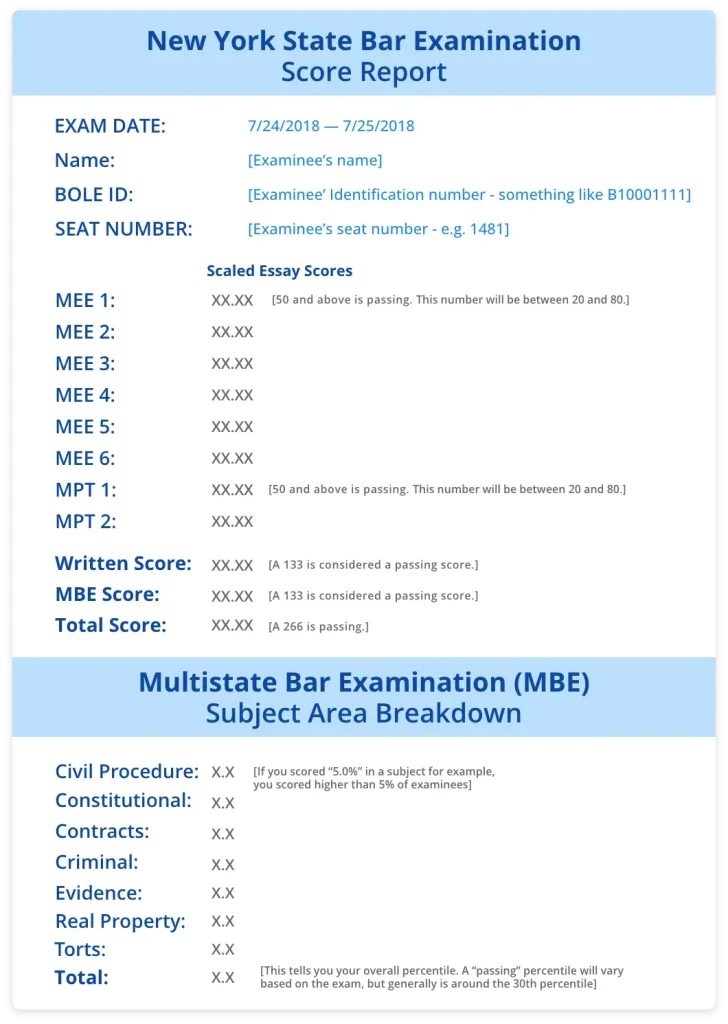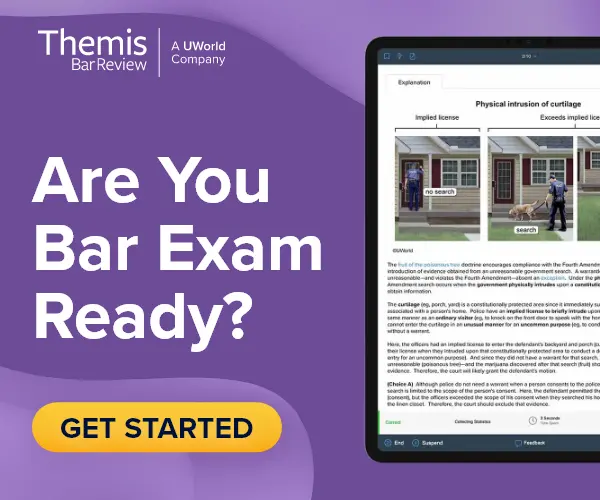Jurisdictions across the U.S. have used the Uniform Bar Exam (UBE®) to evaluate your competency to practice law since 2011. Each jurisdiction sets its own passing score, so review the requirements for where you plan to apply or transfer your score.
You may also like:
UBE Minimum Passing Scores by State
Each UBE jurisdiction sets a minimum passing score, ranging from 260 to 270. Recently, many jurisdictions have re-evaluated these scores in response to national discussions on bar exam difficulty, candidate performance, and the demand for new lawyers.
| Minimum Passing UBE Score | Jurisdiction |
|---|---|
| 260 | Alabama, Minnesota, Missouri, New Mexico, North Dakota, Oklahoma, Utah |
| 264 | Indiana |
| 266 | Connecticut, District of Columbia, Illinois, Iowa, Kansas, Kentucky, Maryland, Montana, New Jersey, New York, South Carolina, Virgin Islands, Washington |
| 268 | Michigan |
| 270 | Alaska, Arizona, Arkansas, Colorado, Idaho, Maine, Massachusetts, Nebraska, New Hampshire, North Carolina, Ohio, Oregon, Pennsylvania, Rhode Island, Tennessee, Texas, Vermont, West Virginia, Wyoming |
How is the UBE Scored?
The National Conference of Bar Examiners (NCBE®) works with jurisdictions to grade and score the UBE, which is composed of 3 components: the Multistate Essay Examination (MEE®), the Multistate Performance Test (MPT®), and the Multistate Bar Examination (MBE®).
- Written Section: Jurisdictions grade the MEE and MPT, while the NCBE provides scaling methods to adjust these scores.
- MBE: The NCBE administers and scores the MBE, adjusting raw scores to account for exam difficulty.
What is Scaled Scoring?
The total number of points you earn based on correct answers is your raw score. However, because exam versions vary in difficulty, the NCBE uses a process called equating to adjust your score accordingly. This adjustment results in a scaled score that fairly reflects your performance, regardless of the exam version.
For example, if Jack takes a slightly harder version of the MBE in July and answers 135 questions correctly, his score might be scaled up to account for the higher difficulty. In contrast, if Jill takes an easier version in February and also answers 135 questions correctly, her score might be scaled down.
Multistate Essay Exam (MEE®) Scoring
The MEE consists of 6 essay questions, each graded on a 6-point scale. Jurisdictions score these essays based on criteria such as issue identification, legal reasoning, and clarity. The combined points from all essays form your raw score.
Multistate Performance Test (MPT®) Scoring
The MPT involves 2 tasks, each graded on a scale of up to 6 points. Jurisdictions evaluate the tasks based on organization, legal analysis, and adherence to instructions.
Multistate Bar Exam (MBE®) Scoring
The MBE includes 200 multiple-choice questions, but only 175 are scored. The remaining 25 are pilot questions that do not affect your score. The raw score is based solely on the correct answers from the 175 scored questions, with no penalties for incorrect answers.
Final UBE Score Calculation
The NCBE combines the scaled scores from the MBE and the written section (MEE and MPT) to produce a total score on a 400-point scale. Here’s how it breaks down:
- MBE: 50%
- MEE: 30%
- MPT: 20%
Jurisdictions grade the MEE and MPT, and NCBE scales these into a single score for the written section. The NCBE also scales the MBE separately before merging the scores to generate your final UBE score.
UBE Score Transfer
Due to its uniformity, the UBE simplifies score transfer between jurisdictions. Candidates who meet the minimum passing score and age requirements of another UBE jurisdiction can request the NCBE to transfer their score directly.
The process is more complex for non-UBE jurisdictions and may require meeting additional requirements, such as taking jurisdiction-specific components.
Learn more about score transfer.
UBE Score Age
UBE score age refers to how long a score remains valid for transfer (typically 3-5 years). Since deadlines and score age vary, be sure to review the requirements for any jurisdiction in which you plan to practice.
| Maximum Age of Transferred UBE Score | Jurisdiction |
|---|---|
| 2 years | North Dakota, Rhode Island |
| 2 years/5 years | Iowa |
| 25 months | Alabama |
| 30 months | Pennsylvania |
| 3 years | Arkansas, Maine, Maryland, Massachusetts, Michigan, Minnesota, Montana, Nebraska, New Jersey, New Mexico, New York, North Carolina, Oklahoma, Oregon, South Carolina, Virgin Islands, West Virginia |
| 3 years/5 years | Colorado, New Hampshire, Tennessee, Utah, Vermont, Wyoming |
| 37 months | Idaho |
| 40 months | Washington |
| 4 years | Illinois |
| 5 years | Alaska, Arizona, Connecticut, District of Columbia, Indiana, Kansas, Kentucky, Missouri, Ohio, Texas |
Score Transfer Fees by Jurisdiction
Each UBE jurisdiction sets its own fee for transferring scores, and costs vary significantly. Some states charge a nominal fee, while others have higher rates to cover administrative processing. Review the chart below for score transfer fees across jurisdictions.
| UBE jurisdiction | Fee for admission by transferred UBE score |
|---|---|
| Alabama | $875 (plus C&F fee) |
| Alaska | $1,000 |
| Arizona | $875 |
| Arkansas | $1,500 |
| Colorado | $810 |
| Connecticut | $750 |
| District of Columbia | $405 (plus C&F fee) |
| Idaho | $600/$800 |
| Illinois | $1,500 |
| Indiana | $500 |
| Iowa | $900 |
| Kansas | $1,250 |
| Kentucky | $875/$1,200 |
| Maine | $900 (plus C&F fee) |
| Maryland | $750 |
| Massachusetts | $815 |
| Michigan | $400 |
| Minnesota | $1,150 |
| Missouri | $1,240 |
| Montana | $155 (plus C&F fee) / $410 (plus C&F fee) |
| Nebraska | $925 |
| New Hampshire | $725 |
| New Jersey | $675 |
| New Mexico | $1,700.00 |
| New York | $250/$750 |
| North Carolina | $1,275/$1,500 |
| North Dakota | $400 (plus C&F fee) |
| Ohio | $750 (plus C&F fee) |
| Oklahoma | $1,250 |
| Oregon | $750/$1,175 |
| Pennsylvania | $650 |
| Rhode Island | $975/$1,475 |
| South Carolina | $1,000/$1,750 |
| Tennessee | $625 (plus C&F fee) |
| Texas | $300/$490/$1,040/ $1,140 |
| Utah | $550/$850 |
| Vermont | $525 |
| Washington | $585 $620 (plus C&F fee) |
| West Virginia | $750 (plus C&F fee) |
| Wyoming | $600 (plus C&F fee) |
| Virgin Islands | $1,100 (plus C&F fee) |
Concurrent Score Transfer
In some UBE jurisdictions, you can request a concurrent score transfer, which means you can transfer your MBE score to another jurisdiction at the same time you receive their results. This allows you to apply for admission in multiple jurisdictions without waiting for separate score releases.
To initiate a concurrent transfer, you submit a request and pay any applicable fees through your NCBE account, specifying the jurisdictions where you want your score sent. Not all jurisdictions allow concurrent transfers, so checking specific policies is essential.
| Allows Concurrent Application | UBE Jurisdictions |
|---|---|
| Yes | Connecticut, Kansas, Kentucky, Maine, Massachusetts, Michigan, Minnesota, Missouri, Montana, New Hampshire, New Mexico, New York, Ohio, Oklahoma, Texas, Utah, Vermont, Washington, Virgin Islands |
| No | Alabama, Alaska, Arizona, Arkansas, Colorado, District of Columbia, Idaho, Illinois, Indiana, Iowa, Nebraska, New Jersey, North Carolina, North Dakota, Oregon, Pennsylvania, Rhode Island, South Carolina, Tennessee, West Virginia, Wyoming |
MBE Score Transfer
MBE score transfer policies vary across UBE jurisdictions. Some authorize the NCBE to handle score transfers, while others manage the process independently or don’t allow for transfers at all. To request a transfer, submit your request through your NCBE account once your testing jurisdiction releases your results.
Learn more about MBE scoring.
How to Interpret Your UBE Score Report
Your UBE score report shows your performance across all exam components and indicates if you meet your jurisdiction’s minimum passing score. Here’s a quick breakdown:
- Total Score: Your combined score from all components out of a 400-point scale.
- MBE Score: Your scaled score from the multiple-choice section out of 200.
- MBE Subject Area Breakdown: Your scores on each MBE subject.
- MEE and MPT Scores: Your scores on each essay question or task.
- Written Score: Your combined MEE/MPT scaled score out of 200.
- Pass/Fail Status: Shows whether you meet the passing threshold
Always refer to your jurisdiction’s bar admission guidelines for the most accurate interpretation.
Frequently Asked Questions
Can I transfer my UBE score to a non-UBE jurisdiction?
Yes. You can transfer your UBE score to a non-UBE jurisdiction, but the process is often more complex and may involve additional requirements such as taking state-specific tests. Contact both jurisdictions for guidance on transferring scores.
Can I transfer my MBE score separately?
How do I request a UBE or MBE score transfer?
For UBE score transfers, submit a request through your NCBE account once your jurisdiction has released your score. For non-UBE or MBE transfers, consult the specific jurisdictions involved for instructions.





